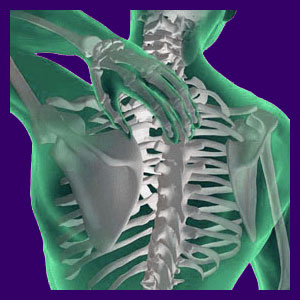
Typical thoracic outlet syndrome symptoms are very similar to many other upper back and neck pain conditions.
They are agonizing, disabling and often unbearable to endure. Thoracic outlet syndrome is a diagnosis on the rise and might just become the next major component of the back pain epidemic.
Thoracic outlet is very different than most other suspected causes of dorsalgia for one main reason. Although a pinched nerve is usually still implicated as being the source of pain, the compression mechanism does not exist in the spine itself. Instead, the deep and/or superficial muscles of the upper back and shoulders are blamed for clamping down on the nerves, causing the symptoms which make thoracic outlet such a nightmarish torture.
This narrative provides a comprehensive account of the symptoms of thoracic outlet syndrome conditions in the upper dorsal anatomy.
Painful Thoracic Outlet Syndrome Symptoms
Pain is the most common and universal symptomatic expression of thoracic outlet. Pain might be localized in the upper thoracic spine and lower cervical spine or might radiate into the head, face, shoulder, axilla, arm, wrist, hand or upper frontal torso. Pain may be constant or come and go. The expression of pain might feel dull, sharp or akin to burning. It is also probable that certain activities and positions might aggravate the painful occurrence, while other positions might alleviate it.
Some patients experience severe headaches along with their upper back pain and neck pain syndromes. These headaches often begin in the upper cervical spine, at the base of the occipital bone and penetrate inwards into the substance of the head itself.
Neurological Thoracic Outlet Symptoms
Nerve compression, typical in TOS, might result in a variety of nasty neurological symptoms in the back, neck, head and upper appendages. Tingling is common, especially in the arms and hands. Numbness and muscular weakness are also common in the back, neck, shoulders, axilla, arms and hands.
There may be discoloration of the affected limb or part of the limb and the pulse might be weak in the affected wrist. Neurological symptoms are often worsened or relieved with certain movements, such as arching the back, turning the head or lying on one side or the other. Trial and error is likely to produce a realm of possible aggravators and alleviators for the pain.
Analysis of Thoracic Outlet Syndrome Symptoms
Thoracic outlet syndrome is becoming a very popular diagnosis for what used to just be called chronic upper back pain. TOS can be even more dangerous in this regard, since it now defines the syndrome with greater clarity, giving patients a real cause for alarm and escalating the nocebo effect of the diagnosis.
While some cases of TOS are obviously linked to trauma, such as in the case of a car accident, many are idiopathic. In these cases, the diagnosis may be incorrect, since the pain might not be due to any vascular or neurological impingement at all.
Most chronic TOS type syndromes can be easily created by simple ischemia of the surrounding back muscles and nerves, acting in a regional process. This is why knowledge therapy should be one of the alternative treatment options considered, especially in cases not caused by a known traumatic event.
TOS is yet another in a long list of treatment-resistant back and neck pain conditions. Be careful about how you proceed with therapy, since the path can be long and twisted and often leads to an unsuccessful surgical ordeal. It may be wise to get more than one professional diagnostic opinion before starting care, including one provided by a neurologist, in order to maximize the chances for successful treatment.
Back Pain > Thoracic Outlet Syndrome > Thoracic Outlet Syndrome Symptoms




